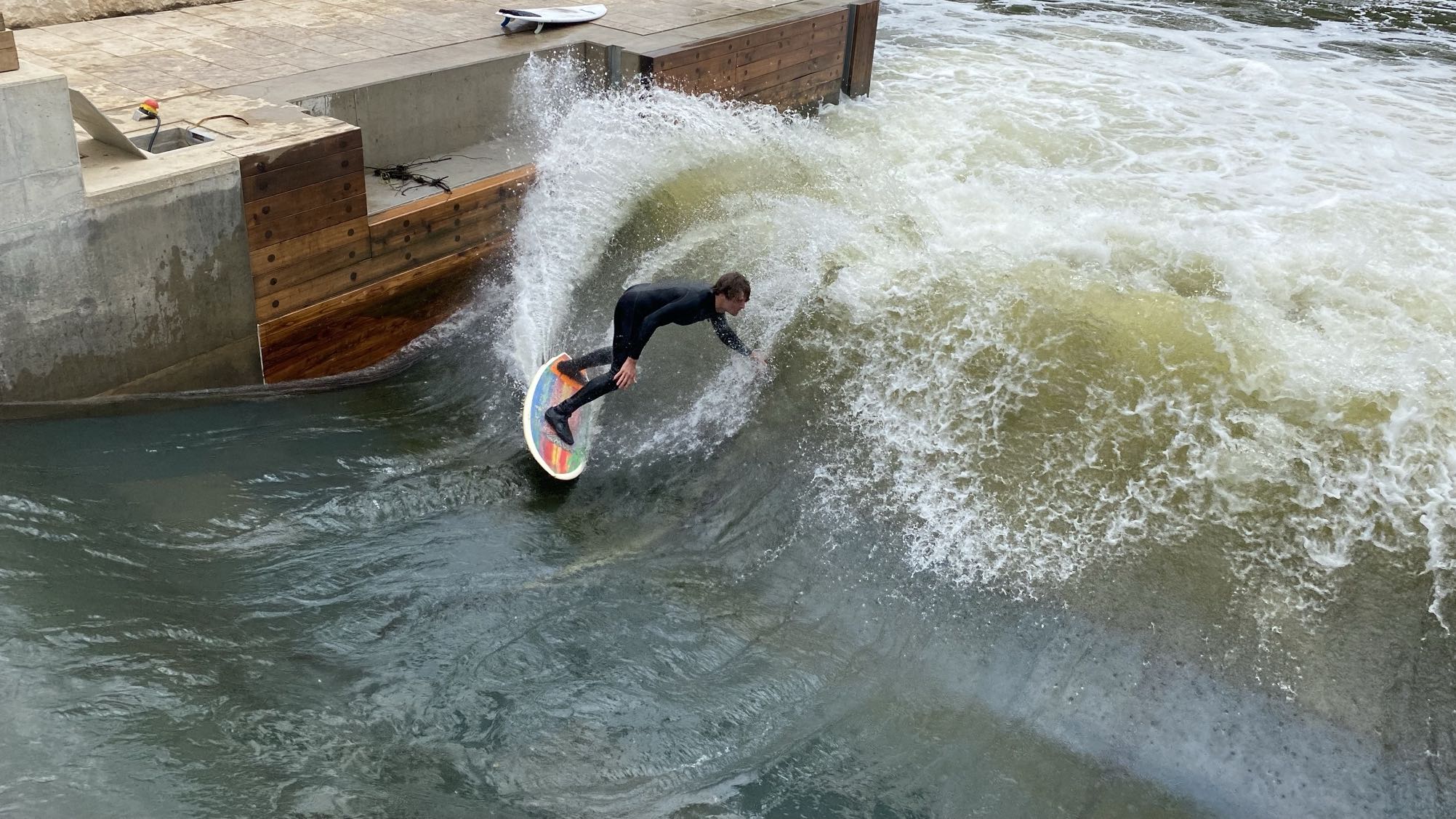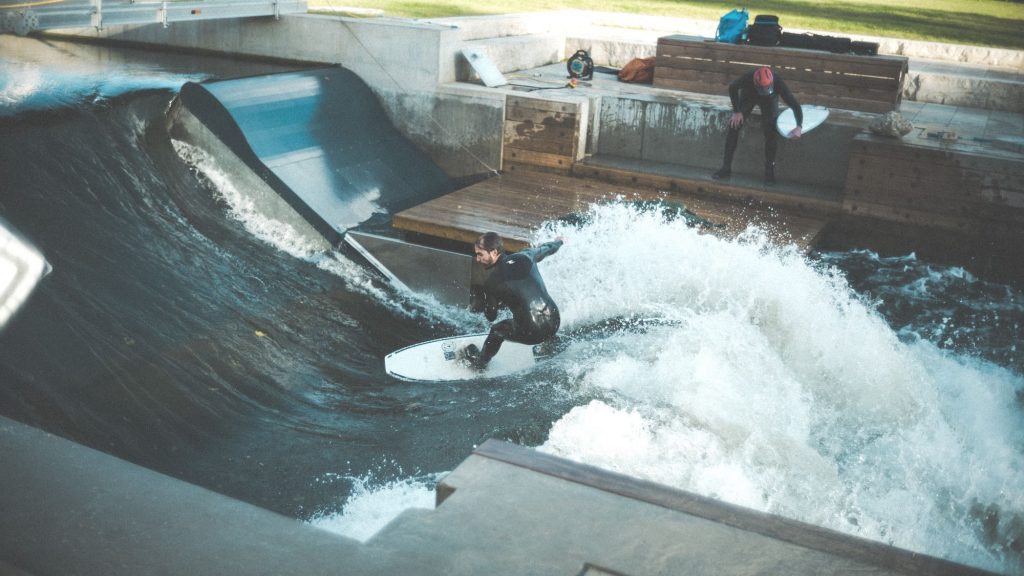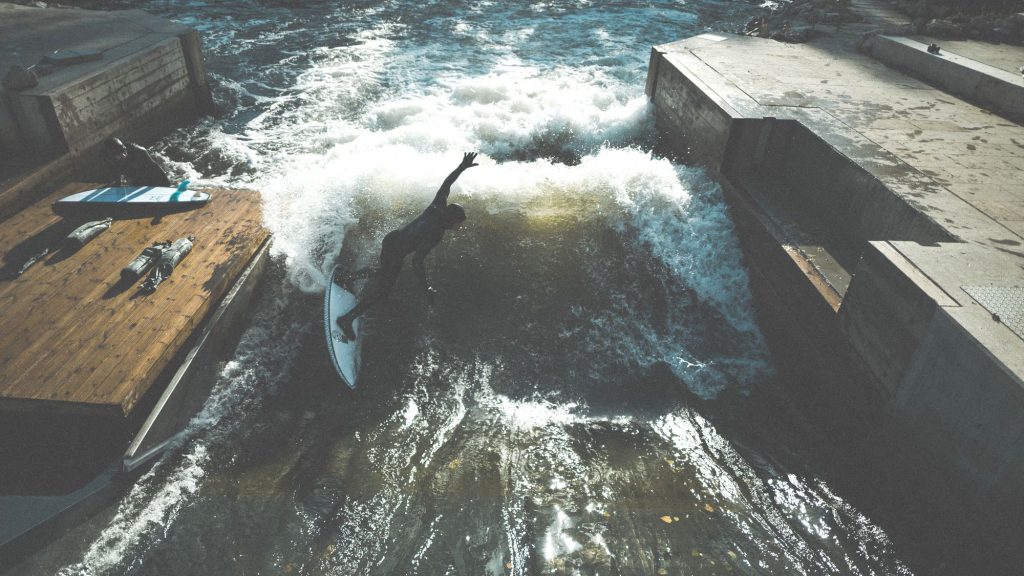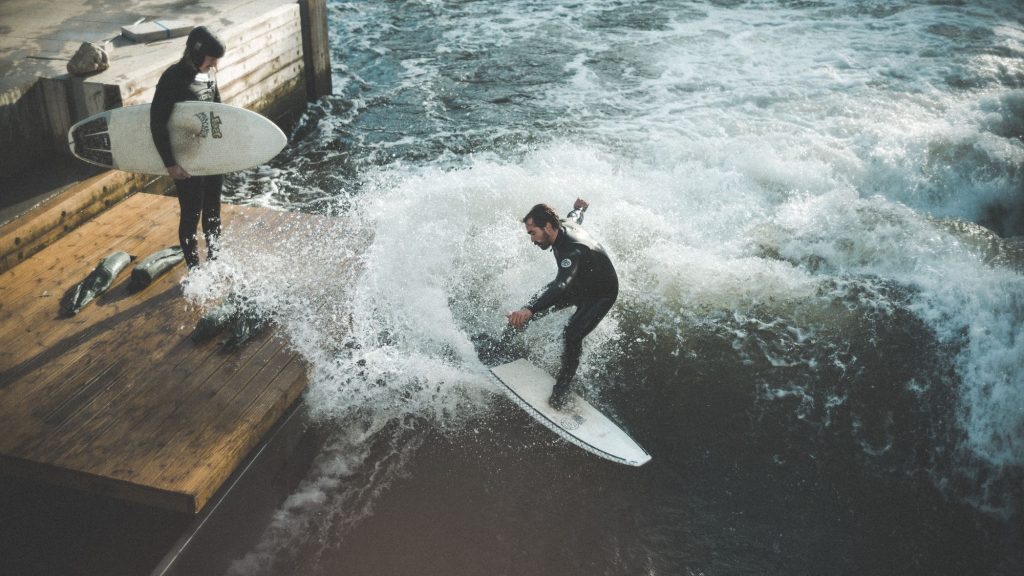No energy required: Meet the rapid wave pool without a motor

One could consider Germany the birthplace of river surfing at natural spots like Floßlände and Eisbach in Munich. From Bavaria it spread into the rivers of Austria and Switzerland and across the pond to the US. Today there are commercial artificial rapid pools popping up everywhere in the world which is great. However, there’s obviously the issue with sustainability through high energy consumption and with a fairly high entry level when it comes to pricing for end consumers, these artificial projects do not exactly grow a core community and a core scene that is inclusive to people from all walks of life, especially kids and students. But a constant influx is necessary to grow a sport.
The only way to achieve this is to push river wave projects where no energy gets consumed once the rapid is operational. Where people can surf by being surf club members like at Dauerwelle e.V. in Nuremberg or soon at Leinewelle in Hanover. Where members pay a small and fair amount per month or per day like at the Riverwave in Austria. Access is the important term here and while a free setup like Eisbach in Munich or Floßlände is the dream scenario, it is (for now) impossible to replicate due to liability issues.
In comes Dreamwave, a company that has specialized in building semi-natural river waves. Through systems like Dreamwave we can make rapid surfing accessible for a huge community in the future because where there’s a river, a little bit of current and a height difference, there’s probably the chance to install a Dreamwave system. We sat down with Lasse Bauer from Dreamwave and picked his brain.

When did Markus Aufleger, Ulrich Hautzel und Derek O’Neill sit down together to discuss the first ideas when it comes to Dreamwave?
Markus is a professor of hydraulic engineering. Already 20 years ago he spent a lot of time in his laboratory together with enthusiastic students. They placed models made of wood and plastic in gutters with running water. They screwed and molded. They tried to create the most beautiful and big waves possible. Ulrich and Derek were thrilled and wanted to play along. Around 2006 they started working together. Together it went even better. The waves became even more beautiful, greener and just better. A long journey together began…
What is the Dreamwave system and why are you using it?
We offer two systems. We call it a single ramp and modular ramp (Dreamwave system). The modular system comes to operation when we face varying discharges. If the amount of water flowing per second is too low, the wave wouldn’t be surfable. That’s why we have to concentrate the flow into a smaller channel and have a higher discharge per unit width. This can be done by blocking a part of the width of the channel by one or more modules. A module can be described by a segment with a damnplate in the front that holds the headwater level. Three or more modules placed next to each other over the width work independently or together to create the optimum wave. Furthermore, it offers the possibility to create user-specific wave shapes such as bowls or even kickers by using different settings on each module. If we do have enough water throughout the whole year, we can use the more simple single ramp, which only consists of one big plate over the whole width of the channel. The steel structure is automatically controlled by software that measures the boundary conditions and forms a wave, which can then be manipulated by the user himself. The whole system can be steered from any mobile device with wifi.
What are the main differences between a pump-driven system and a river wave?
The main difference is the source of the power. While pools use electric energy for the work of the pumps, the energy in the river comes from the water itself. You need a water level difference respectively energy head difference. To get the water in front of the wave to a higher level than behind the wave you need a certain amount of energy, which is not neglectable. Our main goal is to develop sport locations with a green approach in mind, which means keeping the impact as low as possible, not wasting energy, improving ecological parameters and having a sustainable operation for many years. Talking about the river wave itself, the varying boundary conditions change its appearance all the time. A single wave shape is only reproducible to a certain extent, the rest lies in the hand of mother nature. We love that because it brings surfing back to nature, like surfing in the ocean. As already mentioned we implemented an automatic software that adapts to changing boundary conditions and guarantees a safe and surfable wave at all times.
Where you ever thinking about building energy-powered systems as well, such as Unit or Citywave?
Yes, the three of them wanted to build an artificial wave in Portugal in 2008. Markus conducted an elaborate model experiment at the University of Innsbruck. Ulrich and Derek organized the project together with their friends in Ericeira. Everything was perfectly planned. Then the economic crisis hit Portugal. A bitter moment. Their dream and their project were over. A long time then passed. The world changed. Today we build the waves only with the energy of the flowing water. We don’t use pumps. That is our philosophy – sustainable waves for the next generation.

How frustrating was it to put such big effort for such a long time into building a wave in Zillertal and then getting turned down?
Awww you’re putting the finger into the wound. We have to admit that this news hit us hard. This project wasn’t just about showing what the Dreamwavesystem is capable of, but also a great opportunity for the sport which we love doing. We really wanted a wave like this to happen. In this valley, all the ingredients for a perfect wave come together. A decent flow of plus 40qm2/sec, which comes down the glacier reservoir lakes with very high consistency, allowing us to build a 20-meter wide wave reaching up to 1,6 Meter height with water approaching very calmly to have super glassy conditions. All surrounded by great nature, a very good infrastructure like an already existing train station just in front of the location and various great hotels and restaurants nearby. Not to forget, the Hintertux Glacier is further down the valley for skiing in summer, which rounds the place for a really different experience when going on a surf trip. For the company, it would have been a big kickoff with great visibility for everyone as the place just allows “XXL thinking” with all our dreams when it comes down to building a perfect wave in a perfect location. But we don’t give up hope, that the current projects will tease the Zillertal and make them think about it again. I mean, all the planning is done and summer tourism is getting more and more important in the area.
Nuremberg was your first project then, tell us a little bit about the difficulties and challenges putting such a project together.
We learned a lot through this project. The varying boundary conditions at the spot make it a very challenging task to take everything into account. Changing discharges, varying water levels, ecology, sediments, etc..The biggest challenge of course for us as the constructor of the wave was the transformation of a laboratory-scale wave system into a real-size steel structure, stable enough to resist the acting forces and dynamic enough to create the sensitive wave under changing circumstances. Our prototype wasn’t perfect from the beginning, especially since the software development took a few extra laps. But now we are proud to say, that we do finally have a fully automatic wave system, that will create a wave by pushing the start button. We can only imagine how much work the surf club Nürnberger Dauerwelle e.V. put into the development of the project, mainly volunteers. There are many milestones to take on the way to a river break. Accepting fallbacks is a great part of it. But they showed great stamina and made it possible for us to build that wave.
Next up is Hannover and Leine Welle. How are things looking there?
To be honest, the location is probably one of the nicest spots in Hannover, right next to downtown and an old monastery. We finally make good progress. A big challenge here is the location in between historic buildings and walls. These structures are very sensitive and can easily get damaged during building measures. The static had to be recalculated and it took a long time and very technical stabilizing solutions to make sure, that no harm comes to surrounding buildings.If we can go on like this, we hope that the first surfer will jump on the Leinewelle in October 2022.

What are you taking out of the Nuremberg wave in terms of learning when it comes to Hannover?
We gained a lot of confidence in terms of the shape and size of the wave. Its power even topped our expectations. Anyway, we try to optimize certain aspects of the construction to mainly de-complicate the system. Also a simplified but nevertheless functional source code will be implemented. Also, the water level difference is a parameter, that if adjustable, can help us a lot to optimize the wave and the water movements in general. The main learning probably was that everything takes a lot of time.
How many other projects are you working on that you can tell us about?
10 to 15. Projects are popping up all over Europe. They are all very special and in their own way challenging. The current stages of the projects differ widely. While some of them already hold their Wasserrechtliche Genehmigung (the right to build into existing rivers, creeks, etc), other initiatives are looking for a spot that fits the needs and had first contact with us. For the coming two years we count on two new waves, Hannover excluded.
Uh, exciting! Any hints? Germany, Austria or elsewhere?
Germany mostly and you guys will be the first to know.
In an ideal world, where do you see rapid surfing going when you look at say, the German landscape when it comes to rivers and potential?
Germany, having the alps in the South and loads of flowing water, holds a wide variety of opportunities for rapid surfing. Being the capital in the world for this sport also the interest is widely spread. There are so many spots that would fulfill the basic needs of a river wave, that could be developed in an ecologically friendly and sustainable way. It is very important to say that building waves brings the opportunity to improve the ecological situation in the rivers. As it always takes a water level difference between head and tailwater the best spots to develop a wave are weirs or natural drops in rivers that aren’t migratable for fish. When we develop a surf spot, we always put a special eye on the improvement of the bioecological system. This includes for example the implementation of a fish ladder. Furthermore, our green approach, using (almost) no electric energy is enhanced by the use of small hydropower plants working together with the wave. This means the surf spot can even produce energy when we are done with it. There are still many locations that offer this possibility. Maybe one day, surfers from Germany don’t have to travel more than one or two hours to find a break. The ecological costs of traveling surfers from the middle of Europe aren’t low, as the far distances and therefore time-consuming trips make flights almost inevitable. Offering local opportunities won’t just increase the attraction of those cities, as seen in Munich, but also lower the carbon footprint of performing this sport.
Related Coverage
